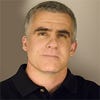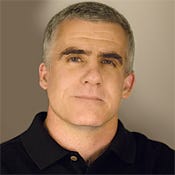Bessant leads BofA's 100,000-person technology and operations group as the bank scraps back from financial and regulatory disaster. Her formula: Steady, reliable performance over glitz.
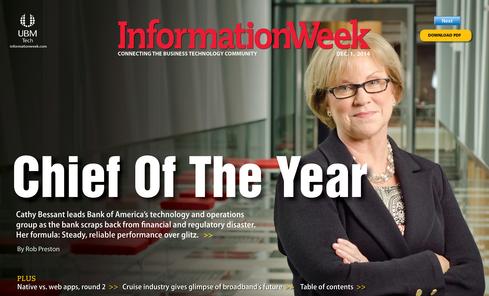
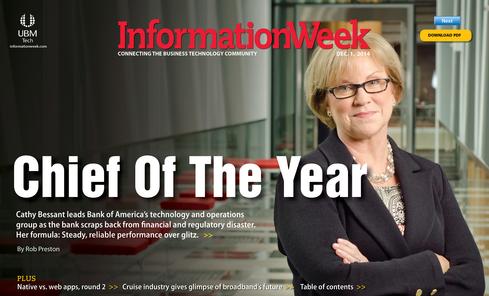 .
.
At the bottom of the job market circa 2002, IT pros who had left Wall Street to chase dot-com riches adopted a new rallying cry: "B2B," short in this case for "back to banking." The implication? Even if financial services wasn't the hottest industry for ambitious technologists, it sure was stable.
Dial ahead a dozen years, and "back to banking" is taking on a slightly different meaning. What's back following the industry's own inglorious excesses, illegal practices, and subsequent collapse is a return to IT basics: standardized architectures and streamlined applications; a commitment to regulatory compliance and information security; and more calculated, customer-focused innovation. That approach may be short on the wow factor, but it sure makes business sense in the aftermath of the financial crisis.
The editors at InformationWeek got to thinking about the financial sectors when we started evaluating candidates for our 2014 Chief of the Year, the CIO or other IT executive who we think embodies what's good and right at the highest levels of the profession. In past years, we tended to pick chiefs at the forefront of technology innovation and business transformation -- Amazon.com CTO Werner Vogels, for instance, or then-Starbucks CIO and digital business leader Stephen Gillett. But what about someone who oversees the unglamorous heavy lifting at a top bank or investment company?
We're confident we found the right chief this year in Cathy Bessant, head of Bank of America's 100,000-person Global Technology & Operations organization. Like much of the financial industry, BofA (including acquisitions Countrywide and Merrill Lynch) did a lot wrong leading up to the 2008 financial meltdown, resulting in tens of billions of dollars in fines and legal settlements, many of them related to the sale of toxic mortgages and mortgage-backed securities. (BofA got -- and later repaid -- $45 billion in federal bailout funds.)
But we're impressed with what BofA has done ever since under the leadership of Bessant, a 32-year company veteran who was named chief of Global Tech & Operations in 2010, having previously served in various nontechnical leadership positions at the company.
In an interview at Bank of America Tower in New York City, Bessant ticks off her IT organization's four main priorities: stabilize the platform, simplify and modernize, reduce the risk (outages, performance problems, regulatory/legal violations), and improve the competitive cost position. Under a four-year plan she put into motion in 2010, BofA has retired more than 18,000 applications, many of them left over from acquisitions. For example, it's spending $100 million to consolidate five Merrill Lynch financial adviser platforms into one, a project due to be completed next year. In its wholesale banking business, 521,000 users at corporate clients in 140 countries now access its CashPro Online treasury and credit management portal in 11 languages; the portal replaced hundreds of applications and systems for everything from liquidity management to currency conversion to wire transfers. Elsewhere, BofA has consolidated 22 collateral management systems down to one. Its eight different teller systems -- now one.
[ Learn more about Cathy Bessant and her strategy: See Bank of America Tech Chief Cathy Bessant: What I Believe and How Bank Of America Taps Tech Startups.]
Figure 2: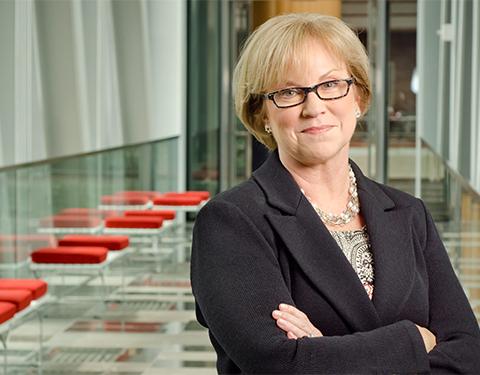 Cathy Bessant
Cathy Bessant
Bessant is unapologetic about her tech organization's long-term, conservative approach. Overly complex, outdated systems didn't cause the bad decisions that led to the financial crisis; simplified, modern systems won't prevent them in the future, but they do establish a foundation that improves reporting, accountability, and customer focus. Reliable systems are part of rebuilding trust in a bank that paid $17 billion in August to settle charges of mortgage fraud.
"The legacy issues in the mortgage space we are getting behind us, and we will get them behind us," Bessant says. "But if they were perceived to be part of a pattern of an inability to perform, they take on a much different proportional importance. I think it means the stakes have been really high for the technology solutions we develop to work, for our platforms to never be down."
The business disruption, and sometimes devastation, caused by the financial crisis also elevated the importance of what Bessant calls "elasticity of assets" -- network, storage, and server capacity that can scale up and down as business conditions dictate. At the same time that BofA has closed about 20 data centers under its IT consolidation, it has developed an entirely new private cloud approach it calls "software-defined infrastructure." By year's end, says infrastructure chief David Reilly, the bank will have about 7,000 workloads on that software and hardware infrastructure, housed in shipping containers to lower the company's real estate costs. BofA intends to do about 25% of its computing on that infrastructure by the end of 2015.
Creating a new data center architecture is the kind of highly technical strategy decision, grounded in BofA's changing needs in a volatile business environment, where it's valuable to have a leader like Bessant, who has worked in all aspects of the bank over three decades, Reilly says. "Cathy brings to these discussions the business perspective first, the risk perspective second, and the technology piece third," he says.
Bessant recognizes that some IT pros want no part of this methodical, cautious approach, and that her organization needs to recruit people with the right mindset. "We operate in a razor-thin-margin environment, and the idea that we are built with a 50, 60, 70% failure rate to find the one shiny object that works is just not the reality of the economic model," she says. "What you have to get a charge out of to be a technologist in banking is the commercial application of innovation. Sometimes I think the most innovative thing we do is our day-in, day-out execution against a master plan."
Shifting money to innovation
Most of BofA's work to get various sales, trading, financial, data center, and other platforms to "target state," as Bessant puts it, "is really a grind." But simplifying the infrastructure and cutting license and support costs have helped the company shift a much bigger chunk of its $9 billion annual IT budget to the kind of innovative work that excites red-blooded IT pros. BofA has doubled spending on new development since 2009, to $3 billion in 2014.
Among the innovations coming out of GT&O are ATMs, now installed in 233 banking centers, that can perform 80% of what tellers usually do, with video chat available for complicated transactions. Information security is another innovation priority. Bessant is pushing for an approach that focuses on protecting and monitoring each data element along with securing the perimeter and watching for insider threats. BofA has run experiments with startups that tag each piece of data so that the company can follow that data across its global network, tracking who has had at it. "It's still a bit Holy Grail-ish. It's something we've all been searching for," Reilly acknowledges. "But increasingly that's where we're putting our focus for the future and looking for companies that can help."
Bessant talks about the broad goal of giving each customer a "bank in your pocket." The 5.0 release of its consumer smartphone and iPad app, launched this year, adds the ability for users to order new debit and credit cards, view their available card credit, schedule appointments, modify scheduled bill payments, add money transfer recipients from their personal contacts, and order copies of posted checks. That app now has 16 million active users, growing by more than 200,000 customers a month. A smartphone/tablet version of the CashPro portal lets corporate clients approve payments and authorize account access, among other features.
BofA points to the 262 "utility" (non-design) patents it was granted in 2013, ranking it 130th among US companies on the Intellectual Property Owners Association's annual list. Since it started filing patents, 19% of its grants have been in programming technology, 17% in check processing/imaging, 16% in online/mobile banking, 15% in information security, 8% in ATMs, and 7% in trading technology.
But when I ask Bessant to cite a couple of IT innovations she's most proud of, she doesn't produce any whiz-bang examples. Instead, she goes to a more workmanlike accomplishment, though one at huge scale: Its support of iPhone 6-based Apple Pay purchases. "To be ready in the first wave with a secure, quality product at the scale at which we operate: That is innovation at a world-class level," she says.
Almost everything BofA does is at massive scale. Earlier this year, it completed the world's largest Windows 7 upgrade, on more than 300,000 computers. It boasts about having implemented the world's largest Cisco authenticated network, the largest SAP general ledger system. The bank's PR team provides more examples of BofA's brute bigness: 5,100 banking centers (more than the number of Wal-Mart stores in the US), 16,214 ATMs (more than the number of US Starbucks stores), 49 million consumer and small-business relationships, 6 billion checks processed annually, 30 million users of its banking website.
P&L girl to tech overseer
Bessant has lived multiple careers during her more than three decades at BofA, having served as president of corporate banking, product solutions, treasury services, consumer real estate, and community development banking, as well as chief marketing officer. She joined the company as a corporate banker in Texas in 1982. "I've had a couple of out-of body-experiences in my life," she says, one of which was her four years as CMO. "I'm a P&L girl."
Bessant comes off as a bit defensive about not having a formal technology education and background, I suspect because she's been poked more than a few times on that subject. While acknowledging that learning the technology "sometimes is a challenge," she says she's "engineering-minded" and has seasoned technical mentors at the company. "You have to be willing to ask questions, find safe places to learn, gut out the people who want to think you're not good because you're not classically trained and they were," she says.
What Bessant hasn't had to learn is how the banking business works, critically important as she oversees not just technology but also operations for businesses that generate more than $80 billion in annual revenue. "I don't understand how it would be possible for someone sitting in my seat to do the job with a pure functional technology background," she says. "The understanding of the business problems, the ability to look at a project for consumer, for wealth management, for sales and trading and prioritize it -- that's one of the most important things I do."
Bessant runs her 11-person tech and operations leadership team a bit like a board of directors. Every few weeks they come together for a KIP review, where they discuss and debate a short list of "key initiative programs," such as that software-defined infrastructure effort and whether to go with a proprietary or OpenStack platform (they had planned to split workloads 50-50, but they're leaning more on proprietary as the open platform matures). Bessant officiates. "As you can imagine, that [format] can be somewhat uncomfortable, but it leads to better outcomes," Reilly says.
Talent seeker
Not surprisingly, Bessant says her top priority is finding and grooming talent, technical and otherwise. She's not averse to going a couple of management layers down in the organization to pull up promising people before others think they're ready. One such promotion was Bill Pappas, who was heading up Global Treasury Payment Operations in London when Bessant tapped him in 2011 to become CIO of Global Wholesale Banking Technology & Operations, even though he had no tech management experience. "It was completely out of left field," Pappas recalls. Another unconventional pick was Laurie Readhead, who Bessant promoted to enterprise chief information and data officer in 2012, even though her experience was in finance and other business roles.
Bessant also isn't averse to spending serious money to snag first-class technologists from other companies, as she seeks "top five" people in the world for key executive as well as specialized tech roles (such as in high-frequency trading). She cites Reilly, who she hired away from Morgan Stanley in 2011 and who now oversees information security and vendor management as well as IT infrastructure, as someone even tech vendors "would kill for."
One former BofA tech manager calls out another exec on the GT&O leadership team: Bridget O'Connor, who Bessant promoted in 2011 to become CIO of consumer banking technology and operations. O'Connor is the C-level technologist driving mobile and data analytics, the former insider says. "Cathy has paved the way for someone like Bridget to one day make the hop from 'I' to 'E,'" the source says. "That's the future: CIOs becoming CEOs."
I ask Bessant whether she herself has ambitions of one day becoming BofA's CEO. She pauses for about five seconds before answering no -- the job is 24 x 7 and places too many demands on one's personal life. "I'm conscious of the fact that an answer like that, at the level that I operate at in this organization, can take away some of my power," she says.
Figure 5: BofA infrastructure chief David Reilly
BofA infrastructure chief David Reilly
It becomes clear during our interview that Bessant, 54 years old, has done a lot of introspection about her own leadership qualities and how she comes off to others. I ask her how her management style is different today compared with earlier in her career, and she responds immediately: "I'm much more authentic than I used to be. There's no show to my go. I don't view anything that we do as a performance or a presentation or an event. And that wasn't always the case, for sure."
The former BofA insider agrees with Bessant's self-assessment: "At that level, tone is important. And she nails it: down to earth, fallible, focused on improving client lives. I wish people on the outside could hear her unfiltered, the way she talks to internal audiences. The sterilization of content by legal/marketing doesn't work in the bank's favor ... at least with her."
Fifteen years ago, Bessant says, people viewed her as a hard-driving machine. She had emotional intelligence but didn't use it, she concedes. One HR partner used to call her "neutron Cathy" -- lots of impact, but lots of collateral damage.
Bessant says being a breast cancer survivor (she was diagnosed with the disease in 2010 and is now in remission) has given her a new perspective on what's not important, like getting credit as opposed to doing meaningful work. She says she's not built to take on the "simple problem," that she loves what she does partly because it's "intellectually hard." Yet those around her won't mistake her evolved approach for going soft: Only one executive (chief operating officer Bill Lorenz) is left from the GT&O leadership team she took over in 2010, "and that has been on purpose," she says. By her design, six of the 11 execs on that team have an operations or other nontechnical background.
Pappas fires off three adjectives to describe his boss: "fearless," "principled," and "passionate." He adds another quality: her ability to receive bad news well. At the scale of a BofA, "not a lot of people come to us with good news," he says, and Bessant not only helps her people analyze a problem, giving them air cover in the process, but she also has a way of firing them up as they seek out the solution.
Bottom of Maslow's hierarchy
Banking wasn't Bessant's first career choice. During her senior year at the University of Michigan, where she was a business major, she took the LSATs and aspired to become a litigator. But the young woman who had grown up in a 900-square-foot house in less-than-tony Jackson, Mich., was drawn to the business cycle of doing good work, getting good reviews, taking home good pay, and getting regular promotions -- a prospect that kept law school at bay and sent her packing for Texas. "I was at the bottom of Maslow's needs hierarchy," she half jokes. "Now I need to be self-actualized, but I didn't then."
Bessant relates the story of her grandfather's death in 1985. She had traveled back to Michigan to visit him while he was sick, but after he died she couldn't afford another plane ticket home. While it wasn't quite a Scarlett O'Hara "as God is my witness..." moment, she says, she decided then that she and her family would never go wanting in that way. "My daughter and my son will be at my funeral no matter how expensive it is for them to get there," she says with a laugh.
Bessant uses the term "true north" several times during our conversation to describe her commitment to consistency and a long-term outlook. BofA and many of its competitors lost their true north in the years leading up to the financial crisis, and as a result they're under intense pressure to do things differently, often more conservatively, in order to toe the line with regulators and, more important, re-earn customers' loyalty. Bessant is the first to admit she doesn't have all the answers. "I'm at the point where I believe it's more important to see things through to execution and have them be 80% right than it is for them to be 100% brilliant but change direction every three or four years," she says. "If the true north is right, consistency and leadership matter."
[ Learn more about Cathy Bessant and her strategy: See Bank of America Tech Chief Cathy Bessant: What I Believe and How Bank Of America Taps Tech Startups.]
Chris Murphy contributed to this article.
About the Author(s)
You May Also Like
